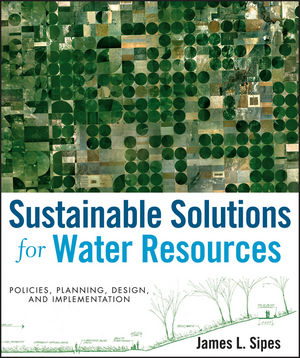Sustainable Solutions for Water Resources: Policies, Planning, Design, and ImplementationISBN: 978-0-470-52962-1
Hardcover
368 pages
April 2010
 |
||||||
Acknowledgments xi
1.0 Overview 1
1.1 The Importance of Water Resources 1
1.2 Overview of Water Resources 3
1.2.1 Rivers and Streams 3
1.2.2 Groundwater and Aquifers 5
1.2.3 Lakes and Reservoirs 9
1.2.4 Wetlands 10
1.2.5 Coastal Zones 12
1.2.6 Precipitation 15
1.2.7 Sources of Information 17
2.0 Issues Involving Water Resources in the United States 19
2.1 Global Warming and Climate Change 19
2.1.1 Impacts of Climate Change 19
2.1.2 Addressing Climate Change 21
2.1.3 Sources of Information 21
2.2 Drought and Water Wars 22
2.2.1 Worldwide Water Wars 24
2.2.2 Southwest Water Wars 24
2.2.3 Southeast Water Wars 26
2.2.4 Peachtree Water Wars 27
2.3 Water Demands 30
2.3.1 Meeting Needs 30
2.3.2 Demands in Las Vegas 32
2.3.3 Uses of Water 33
2.3.4 Options for Meeting Demands 33
2.3.5 Water Sources 34
2.4 Development Pressures 35
2.4.1 Traditional Approaches to Meet Demands 35
2.4.2 Growth in the South 36
2.4.3 The Corps Meeting Demands 38
2.5 Environmental Concerns 39
2.5.1 Wadeable Streams Assessment 40
2.5.2 National Rivers and Streams Assessment 40
2.5.3 Large River Bioassessment Protocols 41
2.6 Economic Concerns 42
2.6.1 Cost of Water 42
2.6.2 Infrastructure Cost 42
2.6.3 Costs of Polluted Water 43
2.6.4 Privatization 44
2.7 Agricultural Uses 44
2.7.1 Impacts 45
2.7.2 Reducing Impacts 47
2.8 Water Quality 48
2.8.1 Water Quality Regulations 49
2.9 Legal Issues 54
2.9.1 Riparian Rights 54
2.9.2 First in Time 54
2.9.3 Groundwater Soil Moisture and Precipitation 55
2.9.4 Direct Flow and Storage 56
2.9.5 Water Law 56
3. 0 Sustainable Planning Approaches for Water Resources 59
3.1 An International and U.S. National Perspective on Water Resources Laws Policies Regulations and Permits 59
3.1.1 Federal Reserved Water Rights 60
3.1.2 National Laws Acts and Policies 60
3.1.3 Other Acts 62
3.1.4 Water for America Initiative 63
3.1.5 Federal Agencies Involved with Water Resources 63
3.1.6 Clean Water Act 66
3.1.7 Water for America Initiative 69
3.1.8 Flood Management at a National Level 69
3.1.9 National Drought Policy 72
3.2 Planning at the State Level 74
3.2.1 State Actions 76
3.3 Regional Approaches to Water Management 82
3.3.1 Interstate Water Commissions 82
3.3.2 Regional Approaches within States 84
3.3.3 Power Companies 86
3.4 Planning at the District Level 88
3.4.1 St. Johns River Water Management District 90
3.4.2 Metropolitan North Georgia Water Planning District 91
3.5 Watershed Planning 92
3.5.1 Conservation Approach 93
3.5.2 Watershed Assessment 95
3.5.3 Tools for Water Resource Analysis 95
3.5.4 Watershed Boundaries 96
3.6 Water Markets and Water Supply Systems 98
3.7 Wetland Planning and Wetland Banking 99
3.7.1 Wetland Recommendations 100
3.7.2 Wetlands Data 101
3.7.3 Wetlands of International Importance 103
3.7.4 National Wetlands Inventory 103
3.7.5 National Data 104
3.7.6 Wetland Mapper 105
3.7.7 Wetlands Master Geodatabase 105
3.7.8 Data at the State Level 106
3.8 Stormwater Management and Erosion Control 107
3.8.1 State Procedures 109
3.8.2 Minimizing Erosion 110
3.8.3 Controlling Pollution 111
3.9 Land Use Planning and Management 111
3.9.1 Land Use and Zoning 112
3.9.2 Ordinances 113
3.9.3 Land Use Data 113
3.10 Shoreline Management 114
3.10.1 Stabilization and Protection 115
3.10.2 Shoreline Ownership and Access 115
3.10.3 Shoreline Use Permits 116
3.11 Natural Resource Protection 116
3.11.1 Local to Federal 116
3.12 Urban Hydrology 117
3.12.1 Existing Systems 119
3.12.2 Impervious Cover Model 119
3.12.3 Sewage and Septic 120
3.12.4 Trees in Urban Watersheds 120
3.12.5 Landscape in Flux 122
3.12.6 Watershed Scale 122
3.13 Groundwater Protection 123
3.13.1 A Sustainable Approach 124
3.13.2 Data at the Local Level 124
3.13.3 Data at the National Level 125
3.13.4 Groundwater Modeling 125
3.14 Water Outreach Efforts 126
3.14.1 Demonstration Projects 128
3.15 Case Studies 128
4.0 Sustainable Practices for Site Planning Design and Implementation 207
4.1 Developing Goals and Objectives 207
4.2 Working with Local Stakeholders 211
4.2.1 Types of Stakeholders 212
4.2.2 Web-Based Communication Technologies 214
4.2.3 Public Involvement Plan 215
4.3 Design Process 215
4.3.1 Research 216
4.3.2 Inventory/Analysis 216
4.3.3 Synthesis 218
4.3.4 Implementation 220
4.4 Lake Management Plan and Actions 223
4.4.1 Lake Water Quality 223
4.4.2 Water Changes 224
4.4.3 Water Clarity Readings 226
4.5 River Lake and Wetland Restoration 228
4.5.1 Hydromodification 228
4.5.2 Stream Repair Practices 229
4.5.3 Fish Passages 230
4.5.4 Constructed Wetlands 230
4.5.5 Unified Stream Assessment 231
4.5.6 Bridging Solutions 232
4.5.7 U.S. Gulf Coast 233
4.6 Low-Impact Development and Smart Growth 235
4.6.1 Low-Impact Development 235
4.6.2 Smart Growth 238
4.7 Recreational Use 240
4.7.1 Marinas 243
4.8 Wildlife Management and Habitat Restoration 244
4.8.1 Habitat Restoration Efforts 244
4.8.2 Federal Wildlife Programs 247
4.9 New Lakes Reservoirs and Dams 248
4.9.1 Tennessee Permitting Process for New Dams 250
4.9.2 Dam Removal 251
4.10 Land Acquisition 252
4.10.1 Fee Simple Acquisition 252
4.10.2 Conservation Easements 252
4.10.3 Leases Deed Restrictions and Covenants 252
4.10.4 Purchase of Development Rights 253
4.10.5 Transfer of Development Rights 253
4.10.6 Land Trusts 254
4.10.7 Acquisition Programs 254
4.11 Best Management Practices 255
4.11.1 BMP Databases 255
4.11.2 Structural and Nonstructural Best Management Practices 257
4.11.3 Vegetative Practices 257
4.11.4 Runoff and Sediment Control 259
4.11.5 Wetlands 259
4.11.6 Rainwater Harvesting 260
4.11.7 Rooftop Runoff Management 261
4.11.8 Filtering Systems 261
4.11.9 Erosion and Sediment Control Plans 262
4.11.10 Controlling Runoff from Croplands 265
4.12 Case Studies 266
5.0 Conclusion 327
5.1 Avoiding Predictions 327
5.2 A Focus on Sustainability 327
5.3 Revisiting Atlanta 328
5.4 Legal Battles 328
5.5 Addressing the Problem 329
5.6 The Future 329
Further Reading 331
References 335
Index 345



